A Xeriscape Guide to Cold-Winter Gardening
Xeric plants thrive on any climate and can flourish on extreme temperatures, extra water, dry conditions, low light, or lots of light. Xeriscaping is one of the best ways of planning an economically and ecologically sound garden. Xeriscape winter gardening can be rock-filled, lush, and can also feature different types of fauna.
The Winter Gardening Challenges
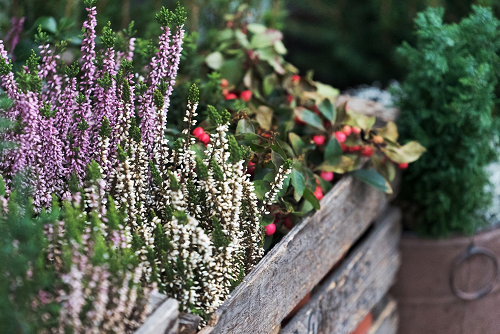
Winter temperatures can cause stress to plants. During winter, there are less angled rays and diminished sun exposure. Rainfall is also limited, meaning that regular irrigation may be needed. The soil type, wind exposure, and the slope must be considered before selecting winter gardening plants. Winter is open to elements such as extreme cold and dryness.
The temperatures may also get to the freezing level. Tender plants need to be located to sheltered locations to keep them from the winds and dryness. Be careful to watch out on slopes. These are of particular concern given that they face moisture runs and winds, which could then create dry conditions. The arrival of winter does not mean that your xeriscape garden cannot thrive.
Go Native
Native plants are adapted to the local weather conditions and soil. They do not require much water and can survive in harsh conditions. These plants support bees, birds, and other wildlife by offering shelter and food. Native flora also protects your yard from wildfires.
Hydrozone
Select water-wise plants during winter, and group them wisely. The same way you would cater to beds based on the plants’ particular needs for sunlight should be the same logic used for water usage.
Plants that need lots of water need to be grouped together. The same applies to native perennials. When selecting your plants, look for those that can keep moisture trapped inside for longer. These are plants with thick leaves and fine hairs.
Maintain Proper Drainage
Xeric plants thrive most in rocky environments, meaning they don’t tolerate too much rain. These plants should be planted in soils with organic matter and little clay. They should also be planted on raised mounds for better water drainage. Instead of raking leaves, use them to mulch the ground. This is an organic layer that encourages nutrients to penetrate the ground leading to a lusher yard.
Xeriscaping is an excellent winter gardening that eliminates the need for supplemental water. It varies from natural landscaping due to the emphasis on the selection of plants that conserve water. For all your xeriscape landscape maintenance needs, call us today or contact us online.
Tips for Yard Maintenance Rohnert Park During the Dry Season
Taking care of a landscape is hard enough when the weather is on your side. When a drought hits, it might become harder to do so. From your grass losing color to reduced resistance to pests and diseases, you might easily start yearning for the weather to get back to normal. As if nothing could get worse, some locations have water rationing laws that you need to follow.
Sure, planting a drought-tolerant landscape can help keep your yard looking green, but this won’t help you if you have a normal landscape. Luckily, there is still a lot you can do to keep your garden looking great when the odds are against you. Besides, you will only need to weather this bad season in preparation for landscape-friendly seasons.
Here are a few tips to keep your lawn looking amazing:
Adequate Water Is Essential For Yard Maintenance Rohnert Park
When drought hits, you need to ensure that your plants get enough water- at least one inch of water per week. This can be done in two sessions. If you are using a sprinkler to do so, you might have to water the plants for a few hours in each of the two sessions. Small watering sessions of 15-20 minutes might not be enough, as water will barely make it into the roots of the plants.
Your watering schedule will also affect your plants’ health, especially if you have to work against water restrictions. Watering between four and seven o’clock in the morning will help keep your plants healthy while avoiding evaporation from the midday heat. Since the water will be deep-seated in the soil, this will allow the roots to grow into the soil to get to it. In turn, this reduces their susceptibility to burning out.
Reduce the Traffic On Your Lawn
Life is hard enough for your lawn without the added foot traffic. Add this, and the grass will be exposed to more traffic, leading the need for future renovations- if the grass survives at all. If possible, restrict your parties to the patio.
In case you have kids, encourage them to play away from the grass. Once the drought passes, these simple sacrifices will be worth it.
Watch How You Fertilize Your Yard
Ideally, you should use nitrogen-rich fertilizer to fertilize your plants. This will produce plants that are deeper-seated, greener, and lower in salt. Healthy soils tend to contain microbial and macrobial life, and most of these animals don’t thrive well in salty environments.
Your rate of fertilization also matters, and moderation is key. If you over-fertilize your lawn, you will either kill it or turn it into a jungle.
Be Prepared For Lawn Recovery
By nature, your lawn is supposed to grow dormant during the drought period- as a way of self-preservation. In this period, it reduces the rate at which it uses resources. Once the drought passes, and you provide enough water and care to your lawn, it will grow regularly and turn green once more.
As such, you need to start preparing for the end of the drought months by stocking up the necessary yard maintenance Rohnert Park materials. For instance, the soil will require aeration to ensure that moisture, air, and nutrients make it to the grassroots. In areas of thinning turf, you might also need to overseed or reseed the affected areas.
Saving water and having a green lawn are actually strategies that can co-exist. In turn, you get to enjoy an amazing landscape when the odds are against its growth. Furthermore, if you maintain a green yard, you won’t have to replant your landscape once the drought passes. You don’t have to do all this yard maintenance by yourself. Feel free to contact yard maintenance Rohnert Park professionals to help your yard survive the drought.
Winter Gardening: How to Maintain a Healthy Garden during Winter
Winter can be a rough time for your garden. From heavy snow to frost forming on the soil, it might seem as if all odds are against your garden. The good thing is that growing a healthy garden during winter is easy as long as you know your way around during winter gardening. If you manage to keep your garden healthy throughout winter, the chances are that it will look even better when spring arrives.
Here are a few insights for caring for your garden throughout winter:
Water Wisely
You need to be careful with the time you water your garden during winter. If you water during the extra cold times of the day, the water might freeze, leading to frost damage. The best time to water your plants would be during the warm times of the day. Since plants tend to absorb water slower during the winter days, and the warmth helps ensure that it flows efficiently through the plant’s system.
Mulch Your Garden
Mulch can not only help to preserve the warmth of the soil but also keeping weeds away. By improving the warmth of the soil, you increase the pace at which water can be absorbed by the plants. It might be wise to use leaves to create mulch, especially after you let them rot since leaf mold discourages the development of weeds. Collect some fallen leaves and layer them over the soil.
Introduce Microclimates into Your Winter Gardening
During winter, you want your garden plants to receive sunlight, but not the cold. This is something that creating a microclimate can help you with. Ideally, this involves creating a greenhouse effect on a smaller scale, and using cold frames can be useful. This will require you to house your garden under a transparent material that will let in some sunlight, but it is hard enough to keep the cold temperature out. Of course, you can always keep these materials away during the hotter months.
Remove Unhealthy Plants
If left to reside alongside the rest of your plants, unhealthy plants can easily spread pests, fungi, and diseases to the rest of your garden. This is the last thing you want for your garden during winter. Get rid of the spent plants. As for any plant that is finished, but is disease-free, uproot it and bury it in your garden. Doing so will revolutionize your winter gardening by introducing organic matter to the soil and improving its general health.
Winter gardening requires a little bit more effort and attention to detail. Show your plants some love during this time, and you can expect them to blossom during the warmer months. Consider the winter gardening tips above to improve the health of your entire garden. Contact us for more gardening tips.
Inspiring Landscaping Ideas for your Front Yard
Every homeowner dreams of a lush and colorful garden in their front yard. While upgrading the front yard with striking landscaping ideas can boost the appeal of any home, it also needs a lot of inspiring ideas for skillful execution.
You can enhance the appeal by settling for the right edges, flowers, shrubs, and plants to complement the aesthetics of your home. Before beginning to design your front yard, create an inventory of the space available. Because there are numerous ideas, decide on the one that best suits your space.
1. Lighting
If you believe your home is a masterpiece, then your landscaping becomes the stage you want to proudly display in a luminous halo. Because every stage has its footlights, your front yard alike needs perfect illumination.
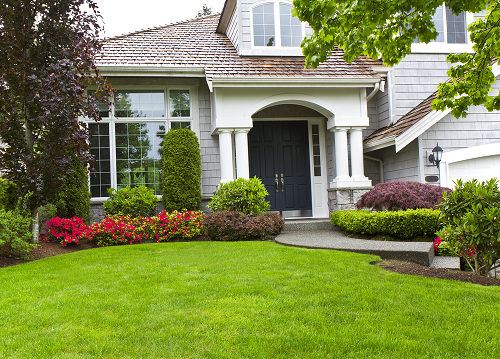
From scene stealing fixtures to subtle accent lighting and canopy to flood, you are sure to find the right option for every style. Inlaid lights for instance show off your landscaping ideas while antiquated lamp-style lighting direct your visitors to your front door after dark.
2. Accent Color Tree
An accent color tree can magically transform your yard by adding seasonal color, scale, shade, and overall structural interest. Choose a species that work for your climate, personal preference, and the design of your landscape.
Going for a small tree with bold colorsto offer your home strong visual appeal. A flowering cherry for example gives the best highlight during spring while a Japanese maple creates vibrant foliage color in autumn.
3. Urns
Classic urns go beyond holding flowers, cremated ashes, and wine, among others. Today, these curvaceous structures are used for many styles as decoration items especially in the front yard.
Large urns add carb appeal by popping color to the garden and serving as fountains. Whether you choose to fill them with plants or leave them empty, urns can be a powerful art element with endless textures, glazes, and forms.
4. Omit the Lawn
Even if you live in an evergreen environment, you can still omit the lawn to create a unique landscape. Avoiding a lawn means you will not spend too much time maintaining it. It means enjoying your outdoor living space in all seasons.
When planning your front yard landscaping, pay special attention to the entrance to ensure it is clear and inviting. Unique structures, plants, trellis to block the wind or rain can do the trick. Remember that every façade has a visual asset and liability. A properly and creatively done front yard goes to highlight the strong points and mask the unattractive ones. Take these landscaping ideas to give your home the highlight it deserves. Contact us for more information.
The Basics of a Sprinkler System Design
A sprinkler system design keeps your lawn adequately irrigated and lush when you are traveling or cannot water your grass by hand. Designing your sprinkler system is creating insurance for your compound, which means that you should grasp all the basics before signing up.
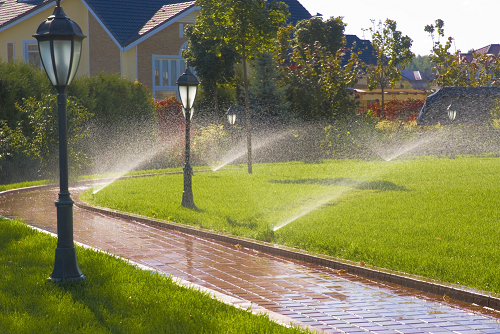
Components of a Sprinkler System
- Sprinkler Heads
There are two main types of sprinkler heads- rotary sprinklers and spray nozzles. Rotary sprinklers rotate along an arc to distribute water while spray nozzles distribute water in a fan-shaped pre-determined pattern. Both sprinklers can be used in pop-up format and on risers.
- Controller
The controller is the part of your sprinkler system that you program to turn your sprinklers on and off at specific times.
- Valves
The valves control the amount of water moving being sprinkled depending on the type of irrigation zone. For instance, a valve will prevent water from being siphoned back to your house due to pressure changes and reduce water pressure where drip irrigation is required.
How to Create Your Sprinkler System Design
- Measure The Area of Your Compound
Pick up a pen, notebook, and tape measure. Proceed to measure the length and width of your compound and draw it to scale. Your map will determine the area for your sprinkler system. Remember to indicate all the features in your home, including the fence, house, walkways, sheds, and driveways.
- Figure Out Your Water Supply
Contact your local water authority to obtain a water pressure report and measure the water pressure in your house at different points. To do this, find a water gauge. Turn off all the water inside your home and connect your water gauge to the spigot outside your house. Then turn on the spigot to measure your output. You should also find out your gallons per minute (GPM) by measuring the time (in seconds) it takes to fill a gallon container from your outside spigot on full blast, and divide it by 60.
- Divide Your Property Into Hydrozones
Divide the total lawn into hydrozones to avoid overwatering or under watering the grass. The types of hydrozones will vary depending on the area and shape, sunlight and shade, types of plants, and the type of soil.
- Design Your Sprinkler and Pipe Layout
Create a drawing and ensure that all parts of your lawn receive adequate irrigation. Lastly, organize all your pipes, valves, and the controller box to determine how you will lay everything on the grass.
Conclusion
Having a sprinkler system will keep your lawn green all year round. If you have any questions on the perfect sprinkler system design, contact us today.
Spruce Up Your Outdoor Landscape with A Rock Garden
Designing your landscape creates an aesthetically appealing ambiance and a sense of satisfaction in your home. One practical way to achieve a satisfying design is by adding a rock garden to your yard. Rockeries, also known as alpine gardens, add texture, beauty, and color to a home, and require minimal attention. These type of gardens emphasizes a variety of rocks, stones, and boulders and incorporate small plants and shrubs to add a contrasting green effect.
Why Should You Choose a Rockery?
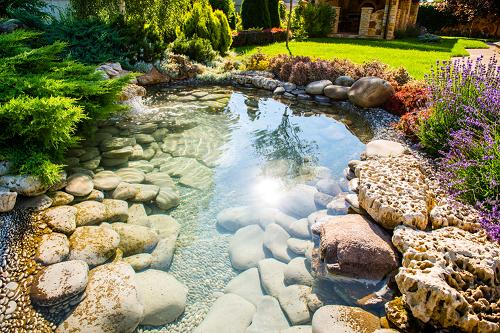
ckeries can withstand harsh weather as compared to greener gardens. Even without rain, your rocks will remain sturdy, unlike green plants that wither away. If you live in drier zones, rockeries are suitable because they contribute to water conservation, while still providing beauty to your home. A rockery will also cut down your maintenance time by eliminating tasks such as weeding, watering plants, and pruning flowers. Lastly, no matter how small your compound is, a rockery will fit and add to the diversity of your landscape without overcrowding your yard.
How to Create Your Rock Garden
The concept of rockeries is to recreate the features naturally existing in your yard. If your landscape is naturally rocky, then you can use the rocks in your compound. If not, should invest in sound design and materials to achieve drainage and aesthetics.
- Sketch Out Your Plan
Map out the idea of your garden using a pencil and paper. Sketching your alpine garden will save you time once you start laying the rocks and plants. It will also ensure you acquire all materials before creating the garden.
- Take Out the Weeds
Rockeries are appealing when all stones and vegetation exist harmoniously. When weeds crop up between boulders, your garden becomes unruly, which is why you should start by weeding your yard. Ensure that you pull out all unwanted vegetation by the roots or apply herbicide a few weeks before laying your garden.
- Drainage
Once you have cleared out the vegetation, dig out at least 60cm of soil in well-drained areas, or one meter if you live in a clay region. Backfill with well-drained material such as rubble, hardcore, stone chippings, and coarse sand. After backfilling, add bone meal, manure or compost to the landscape to promote plant growth.
- Choose Your Rocks
Your choice of rocks is entirely dependent on your design. Smooth stones are suitable for gardens with water features and ponds. Alternatively, you can use large boulders as a focal point by laying small rocks around them. You can also use colored stones to create mosaics and create contrast in your garden. If you have a sloping landscape, consider creating a terraced landscape featuring plants in between the terraces and a rocky path down the hill.
- Choose Your Plants
Alpine gardens work best with small plants and bushes that can survive in shallow soils. Go for alpine-origin vegetation and drought-resistant plants. Daffodils, tulips, brodiaea are tiny and add color to the garden. If you are recreating a Japanese Zen garden, focus on pruned bushes and moss. However, if you live in an arid region, opt for succulent plants spaced evenly between the rocks.
- Incorporate Pottery or a Water Feature
Pottery is an effective way to add color to your garden while still creating space for plants. If your landscape is extremely rocky, pots are a cost-effective method of adding vegetation to the yard. You can add a pond or a small waterfall to spice up the garden. The sound of water cascading down your rock formation adds a sense of serenity.
Conclusion
Rockeries are a great way to improve your yard and bring a peaceful meditative ambiance to your home. With the right help, you can create the perfect rockery for your home. If you are looking for professional help with your rock garden, contact us today.
Landscaper Rohnert Park: Maintain a Beautiful Yard
If you have ever walked into any building or garden landscape in Rohnert Park California and you felt warm and welcome, chances are that the yard was cleaned, creatively designed and well maintained by a professional landscaper in Rohnert Park.
A well looked after yard is a sight to behold and creates a serene atmosphere that is second to none. However, this does not happen automatically. For you to enjoy a beautiful, lush and green yard, you will need to make a few investments. These include time and patience. You also have to get the right information that will guide you on the best way to go about it.
Tips From a Professional Landscaper in Rohnert Park
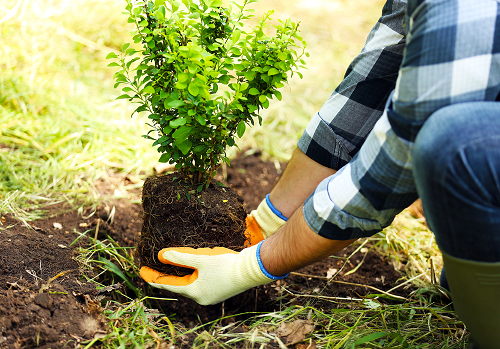
Fortunately, if you are looking for a landscaper in Rohnert Park, you don’t have to break a sweat. In this article you will learn how to transform your yard from a boring one into something that you can proudly look forward to come home to.
Here are different ways to ensure that your yard is elegant regardless of the season.
- Start right
Just like in every other aspect, the foundation will more often than not determine the outcome. In this case, since you will be dealing with soil, it important to have it right. In most cases the soil acidity level, commonly known as pH is high, thus hindering proper growth of grass. It is advisable to take some soil samples for testing and advice on the best way to fix any problems that may present.
It is also important at this stage to get the right information on what is the best type of vegetation to consider. There is no one size fits all vegetation. While some may be suitable for a certain location, they may be unsuitable for you.
- Access unique needs for your yard.
Whenever you have plants be it grass, trees or flowers, it is important to understand that they all have unique needs. Grass in the shady areas, for example, will need less water and fertilizer as the level of evaporation is low, and they grow less. And the opposite it also true. Having this in mind will make is easy for you when undertaking your daily yard maintenance.
- Create a monthly routine based on seasons
Different seasons present different challenges for maintaining lawns. If you have been keen to look around, you may have noticed that most people take care of their lawns during summer and barely touch them after. Unfortunately, due to the negligence, these lawns do not thrive well. To ensure that your backyard yard remains attractive throughout the year, you need to carry out specific tasks based on the season.
- Spring time is the best time to strengthen your grass in readiness for the expected warm days. It is during this season that you should rake to remove any twigs and leaves, mow regularly, apply fertilizers when the soil is moist and also sow new grass to fill in any soil patches. Remember that proper covering discourages weed growth.
- During summer, the activities are centered on maintenance activities. You will engage on more watering, mowing and applying fertilizer.
- In autumn, leaves may suffocate grass. To avoid this, there is need to aerate the yard, mow the lawns and apply some fertilizer.
- Winter season has the least activities in yard maintenance. You only need to remove any leaves that may have fallen over and avoid stepping on the grass. However it provides the best season for planting a new lawn.
A lawn make-over is just what you need if your lawn isn’t in great shape. For more tips on yard maintenance, repair, irrigation and water saving landscape design, feel free to contact us.
Shrubbery Like Boxwood, Lavender, and Camellia
Adding shrubbery to your home’s outdoor landscape is a wonderful way to frame your garden and border a winding path. One particularly popular way for doing both, or either, is with evergreen shrubs.
Benefits of Evergreen Shrubs
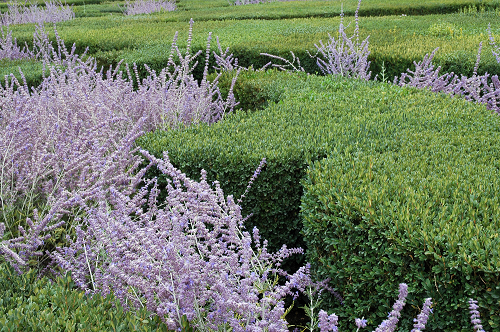
Evergreen shrubs are shrubs that can be a permanent fixture in your garden thanks to the fact that they will last all year.
In fact, evergreen shrubs like fatsia, lavender, and camellia can create beautiful flower displays and perfume-like scents throughout the year, even when everything else in your garden appears to have fallen dormant.
Evergreen shrubs will often be naturally variegated and create a colorful cascade of colors over your garden. Some shrubs are like trees and come with needled or broadleaf foliage.
Adding shrubs to your property will beautify the landscape all four seasons and provide a smooth transition between taller trees and the groundcover plants lining your walkway or garden.
Shrubs can be used for a number of different purposes beyond lining walkways and framing your garden as well.
Shrubbery can provide groundcover on slopes, buffer ambient noise from entering your home, and provide a breathtaking backdrop for your garden.
Boxwood Shrubs
One of the easiest-to-work-with types of evergreen shrub is boxwood shrubbery. Boxwood is hardy to zone 6, which essentially means that it will maintain its integrity no matter what nature throws at it.
Boxwood also fits most people’s initial idea of a shrub – boxwood has tiny, glossy foliage that can be hedged by Xeriscape’s landscaping experts into just about any desired shape.
Most homeowners like their boxwood shrubbery to be a few feet in diameter but, left to its own devices, boxwood can grow up to two dozen feet tall! This is a hardy shrub that will grow well in moderate sun and ligher shade.
Lavender
Lavender is a drought-tolerant plant that is a kissing cousin to mint, and each has a similar fragrance. Lavender, though, is a perennial shrub that has a lot of different size and color options to match your landscape.
There are actually four main types of lavender that homeowners in North America typically consider for their gardens: English lavender, Spanish lavender, Portuguese lavender, and lavandin.
English lavender owes its name to the English lavender trade of the 1700s and the fact that it smells so wonderful. English lavender can furnish homeowners with those variegated colors alluded to above: purples, violet, mauve, and mixtures of all three are afforded by English lavender.
Spanish lavender will come with pink and purple petals and have a unique pine scent. Portuguese lavender (a.k.a., Broadleafed lavender), on the other hand, will have paler purple leaves that are slightly larger.
Portuguese lavender can cross-pollinate with Engligh lavender, and both types are used in aromatherapy. The camphor in Portuguese lavender is good for attracting friendly insects into your garden and lending a sense of exotic variety and soothing color.
Lastly, lavandin might be a fancy name in this context since lavandin only means a cross between English lavender and Portuguese lavender. Lavandin produces sterile seeds but can grow in hot, arid climates and live through periods of sustained drought.
Camellia
Camellia is also a type of evergreen shrubbery, but the flowers of a blooming camellia are truly unique in certain species. There are more than 300 species of camellia, and approximately 3,000 hybrid species. Some camellia flowers are double.
Where does camellia work? Woodland gardens with dappled sunlight or gardens with slightly acidic soil are especially promising foundations for camellia.
Ask Xeriscape about the possibility of installing camellia shrubbery around your garden because the flowers come in a variety of beautifying colors: pinks, reds, yellows, and whites are common. Contact us for more information.
Discovering the Best Flower Bed Ideas for Your Home
Flower bed ideas are typically broken down one of two ways – by the color(s) that you’re going to be using and, secondly, by the kinds of materials you might use to bring your flower ideas to life (e.g., wheelbarrow flower beds).
Monochromatic Flower Beds
Monochromatic is a blend of two words – mono, which means one, and chromatic, which refers to color. Monochromatic flower beds are designed from blooms that are all the same color.
A monochromatic flower bed can add a splash of color to your outdoor landscape, and the thing to bear in mind is that, although everything will be one color, you can use various shades and textures to create a stunning effect.
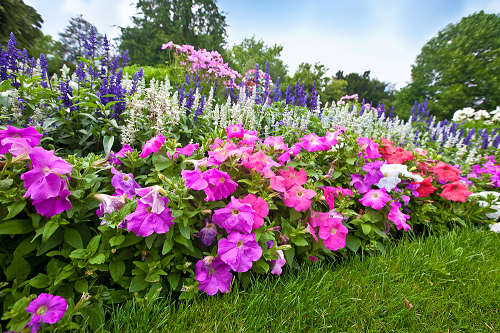
Purples and yellows are very popular variations when it comes to monochromatic flower bed ideas.
With a purple monochromatic flower bed, you have a lot of beautiful flowers to choose from: lavender, sage, leather flower, hydrangea, and grape hyacinth. A walkway lined with lavender can be absolutely breathtaking.
A yellow color scheme is also a popular choice for monochromatic gardens. Yellow gardens let you blend in deep golden hues with paler flowers with an almost buttery accent.
The Denver Daisy – a.k.a., Black-eyed Susan – and marigolds are great for adding deeper shades of yellow to a backdrop of a more mellow flower like the annual nasturtium.
Keep in mind that blues, whites, and violet flowers will have a more calming effect in your garden whereas warmer colors like red and yellow can create instant excitment!
Dichromatic and Ombre Flower Bed Ideas
Dichromatic means two colors wheras ombre is a French word that means you’re going to be using a blend of colors that gradually blend in to each other.
If you only want to use two colors, with varying shades of each color, then you probably want to look into a dichromatic garden. You’ll also want to consider using contrasting yet complementery colors to create the most powerful aesthetic look.
If you’re feeling more adventurous, then an ombre flower bed might be the way to go. Ombre flower beds typically blend some of the cool hues and warm hues discussed above to gradually blend in flowers with a lighter hue with dark hues.
An ombre flower bed typically starts off with a walkway made of flowers of a cooler, softer hue so that the eye gradually gets more and more captivated with the darker tones at the back of the garden.
Wheelbarrow Flower Garden
Sometimes called wheelbarrow planters, a wheelbarrow flower garden can be made using a wheelbarrow that’s rusted-out, cracked, or has a broken wheel.
The wheelbarrow, though, should have holes in the bottom to allow excess water to drain out. The big benefit to a wheelbarrow flower garden is that you can move it to an area with more sunlight.
Walkway Flower Beds
As alluded to above, a walkway flower bed can be a wonderful segue into a captivating garden or a landscaping effect all its own.
Millions of homeowners have already beautified their homes with a walkway flower bed culminating with their front door.
Walkway flower beds actually touch on a difference with gardens in general – a walkway flower bed would be an example of a formal garden path with right angles and straight lines.
That said, a walkway flower bed could open up into an informal pathway kind of garden (the second type) where you would have a meandering or curved path. A crescent-moon type of garden in the front yard would be an example of this second type.
Which flower bed ideas appeal to you most? Contact us for more information.
Four Main Types of Irrigation Systems
Reduce water output by simply installing an irrigation system in your garden. These systems help to conserve more than half the amount of water that’s normally used when watering plants manually. Encourage and practice smart water usage techniques when using any of the four main irrigation methods. See these methods below:
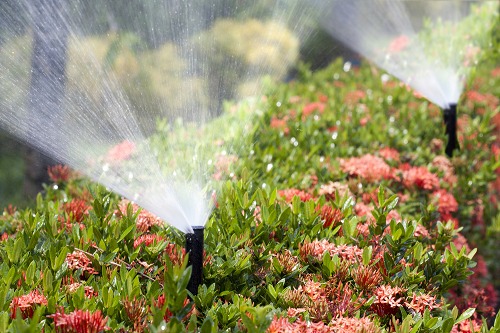
- Subsurface irrigation– This is one of the most frequently used irrigation methods. Homeowners set up this system by applying water underneath the soil. This technique can be altered if the water table is low. When this happens drip or trickle devices can be used as an alternative and be turned on when planted below the soil in direct contact with the plant’s root.
- Surface irrigation Gardens with medium to fine soil textures would benefit from this type of irrigation system. It is also works well with flat sloping land due to its ability to use gravity and siphons to transport water.
- Sprinkler irrigation sprays water through the air and the devices can be either be portable or permanently set in place. Water is pumped through a piping system , sprayed through the air via spray heads that are designed to break the water up into small droplets which then fall on your lawn.
- Drip/trickle irrigation Ever heard of micro-irrigation? This method can be defined as a way to save both nutrients and water all at the same time. Water should be applied in the root zone either from above or below the soil’s surface. This type of system can be more efficient than other methods of irrigation once it is well designed, installed, maintained, and operated.
By now you should have an idea of the factors that influence your choice of irrigation system. Examine your soil type, water table and personal choice etc. Choosing the best type of irrigation system should be your no.1 priority. The right amount of water supply is crucial in maintaining the health and of your garden. You want to create a landscape that is beautiful and lustrous. Contact us today for more information.





